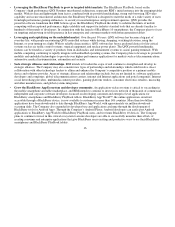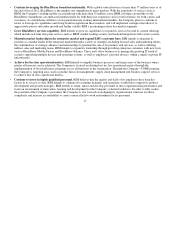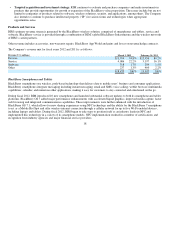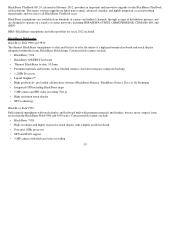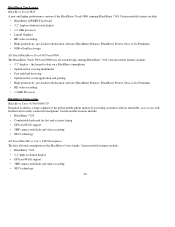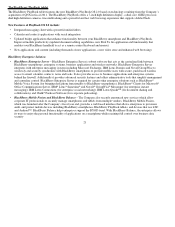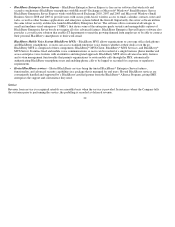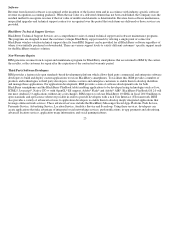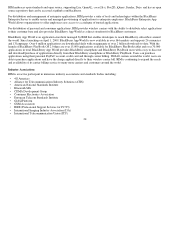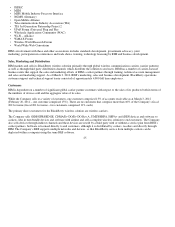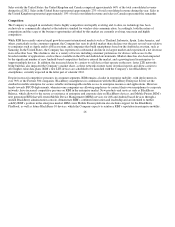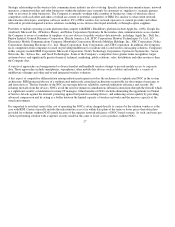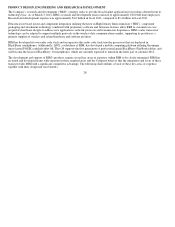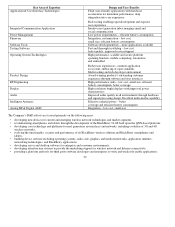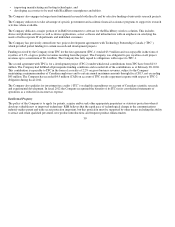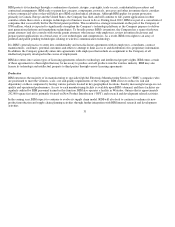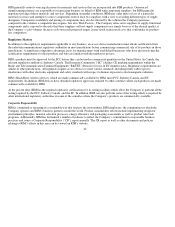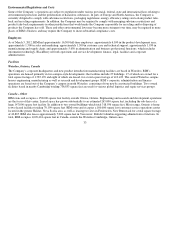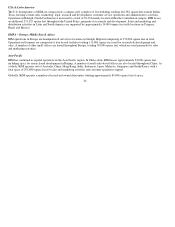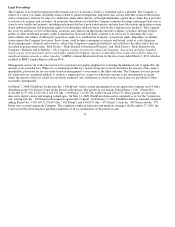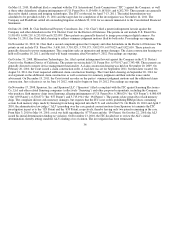Blackberry 2012 Annual Report Download - page 33
Download and view the complete annual report
Please find page 33 of the 2012 Blackberry annual report below. You can navigate through the pages in the report by either clicking on the pages listed below, or by using the keyword search tool below to find specific information within the annual report.
Sales outside the United States, the United Kingdom and Canada comprised approximately 60% of the total consolidated revenue
during fiscal 2012. Sales in the United States represented approximately 23% of total consolidated revenue during the year. Sales in
the United Kingdom represented approximately 10% of total consolidated revenue and sales in Canada represented the remainder.
Competition
The Company is engaged in an industry that is highly competitive and rapidly evolving and, to date, no technology has been
exclusively or commercially adopted as the industry standard for wireless data communication. Accordingly, both the nature of
competition and the scope of the business opportunities afforded by this market are currently evolving, uncertain and highly
competitive.
While RIM has recently enjoyed rapid growth in many international markets such as Thailand, Indonesia, Spain, Latin America, and
others, particularly in the consumer segment, the Company has seen its global market share decline over the past several years relative
to companies such as Apple and its iOS ecosystem, and companies that build smartphones based on the Android ecosystem, such as
Samsung. In the United States, the Company has experienced a substantial decline in its largest market and experienced a net decrease
in its subscriber base. This decline is due to a variety of factors including consumer preferences for devices with access to the
broadest number of applications, such as those available in the iOS and Android environments. Market share has also been impacted
by the significant number of new Android-based competitors that have entered the market, and a growing trend in enterprises to
support multiple devices. In addition, the increased desire by carriers to sell devices that operate on the new, faster LTE networks
being built has also impacted the Company’s market share, as these networks feature faster download speeds and allow carriers to
offer higher-value data plans. RIM’s first LTE devices are scheduled to be launched with the Company’s first BlackBerry 10
smartphones, currently expected in the latter part of calendar 2012.
Despite increased competitive pressures in consumer segments, RIM remains a leader in enterprise mobility, with deployments in
over 90% of the Fortune 500 companies. BlackBerry smartphones in combination with the BlackBerry Enterprise Server set the
standard in mobile enterprise for secure, reliable and manageable mobile access to enterprise resources and applications. However,
trends towards BYOD deployments, wherein some companies are allowing employees to connect their own smartphones to corporate
networks, have increased competitive pressure on RIM in the enterprise market. New products and services such as BlackBerry
Balance, which allows for the secure co-existence of enterprise and corporate data on BlackBerry devices, and Mobile Fusion, RIM’s
next generation BES that will extend Mobile Device Management (MDM) services for iOS and Android based devices through a
unified BlackBerry administration console, demonstrate RIM’s continued innovation and leadership and are intended to further
solidify RIM’s position in the enterprise market. RIM’s new Mobile Fusion platform also includes support for the BlackBerry
PlayBook, as well as future BlackBerry 10 devices, which the Company expects to reinforce RIM’s reputation in enterprise mobility.
26


